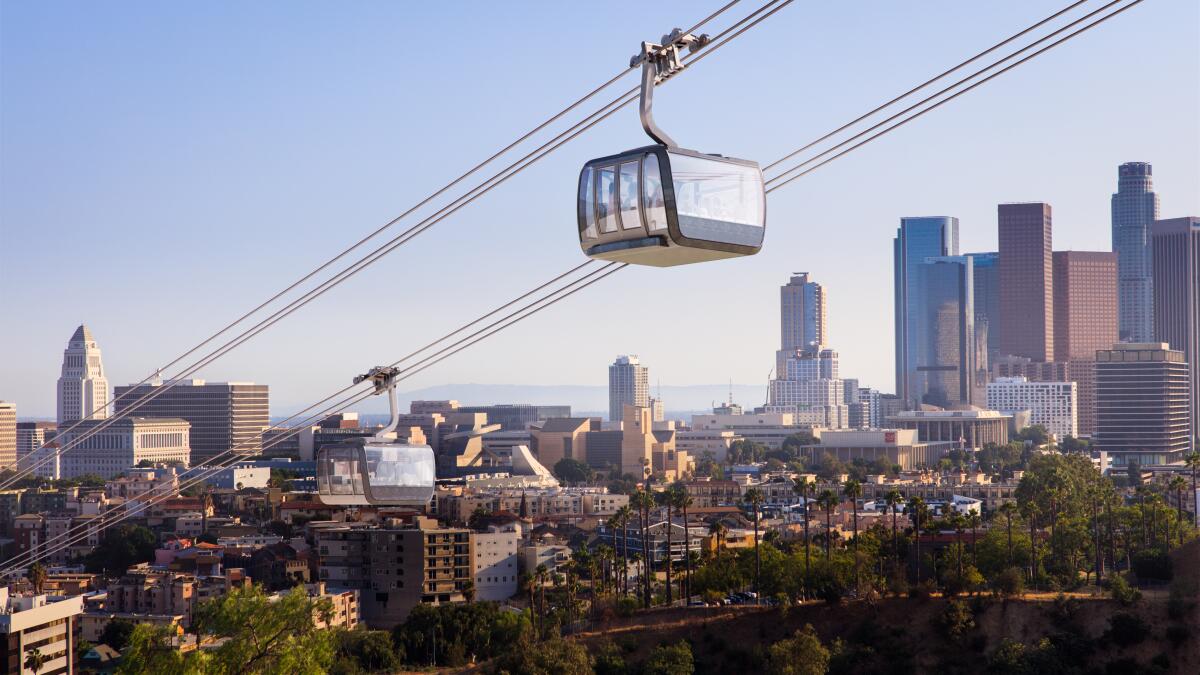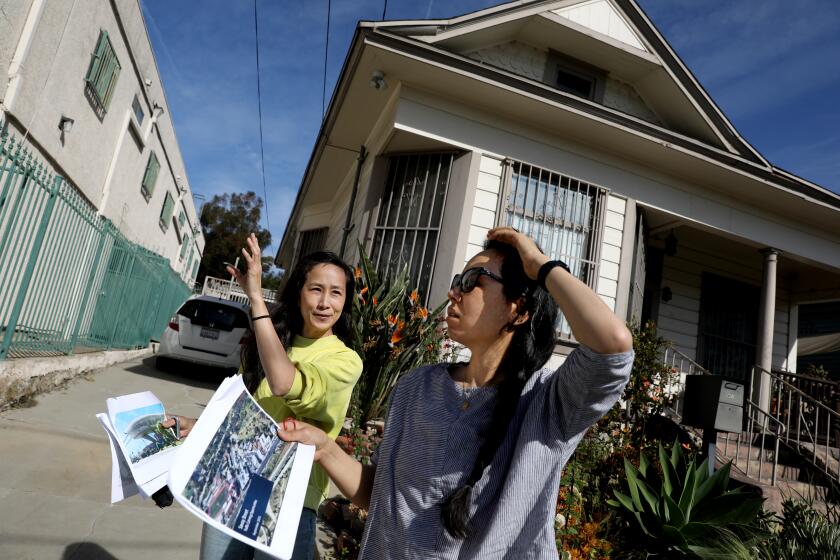Toys, turkeys and grants: How backers and critics of the Dodger Stadium gondola are wooing locals

Maria Lemus doesn’t remember exactly when she heard about a proposed gondola between Union Station and Dodger Stadium, but it was probably at the back-to-school backpack giveaway or the Christmas toy giveaway.
The gondola’s team had been showing up at her family’s housing project, the 415-unit William Mead Homes, for “the past four or five years” to make the pitch for the 1.2-mile gondola over Chinatown and answer doubters’ questions. The homes are less than a quarter-mile from Los Angeles State Historic Park, one of three stops along the route.
“They have been coming to community events,” she said. “They have given our kids scholarships. They have brought turkeys and baskets of food to our community for Thanksgiving.”
A company funded by former Dodgers owner Frank McCourt first proposed the gondola in 2018, selling the idea to politicians, the community and others as an alternative to the congested entry into the stadium that clogs neighboring streets.
On Thursday, the project passed a major hurdle when the board of the Los Angeles County Metropolitan Transportation Authority approved the project’s environmental analysis in an 11-0 vote, with one abstention from county Supervisor Janice Hahn.
The approval was accompanied with a long list of conditions intended to protect the public agency from cost overruns and provide community benefits that would offset harm to Chinatown’s housing market. Hahn said she appreciated the addition of the conditions but said: “I don’t love this project. I really never have.”
The conditions introduced by county Supervisor Hilda Solis, Los Angeles Mayor Karen Bass and three board allies include free rides for Chinatown residents, a regional bus program to the stadium, a community development package with a fund for residents displaced by housing costs, protections to prevent taxpayer liability, and stipulations that would require affordable housing should Dodger Stadium parking lots be developed.
“This project has been advertised to this board and the public as a way for improving traffic congestion,” said Solis, who represents the area. “It should not be used to enrich private interests.”
“These conditions are not negotiable. If any single condition is not satisfied, the project simply can’t be built,” Solis said.
More than a hundred supporters and opponents showed up at Metro headquarters , a reflection of the intense ground campaign both sides have been running. Nowhere has that been more clear than at William Mead, where long-standing political rivalries and residents’ fears of gentrification have all become entangled in the fight.
During two hours of testimony, a stream of area residents begged the board not to trust McCourt, who took the Dodgers into bankruptcy, and warned that the project would cause housing costs to rise. Residents supporting the project said the gondola will spur economic development, reduce greenhouse gas emissions and inspire Angelenos to get out of their cars.
“It’s going to be good for the whole community there,” said Manuel Luna, who has lived in William Mead for 22 years.
But the specter of historic displacement hangs heavy in this part of L.A., where Latino families in Chavez Ravine were uprooted to build Dodger Stadium and a piece of the original Chinatown was moved to build Union Station.
“It’s a perpetuation of the endless cycle of steamrolling communities,” said Tany Ling, who lives under the gondola’s path in Chinatown. “Any approval is saying it’s still OK to sell out the community.”
The project’s environmental impact report estimated the seven-minute lift would cost $500 million to build and ferry 5,000 people an hour to games. Construction costs would be partially covered by bond financing, Metro executive Holly Rockwell said, but she did not say how the rest would be covered. She also said public financing is not being sought.
McCourt owns the parking with the Dodgers, and opponents have long believed the primary reason he is pursuing the project is to eventually develop those parking lots.
“Today’s outcome was shameful, but this fight is far from over,” said Jon Christensen, founding member of LA Parks Alliance. The group formed to fight the gondola and said it intends to file a lawsuit to block the project, contending that the environmental analysis is “fatally flawed,” failing to account for potential development along the parking lots.
The aerial gondola proposed for Dodger Stadium sparks fears of accelerated gentrification, and a lawsuit to stop the ‘sweetheart deal.’
William Mead’s low-slung, garden-style brick homes sit along five blocks on the eastern edge of Chinatown. The two- and three-story buildings, built in the 1940s, are squeezed amid the state park, the Twin Towers jail, the Los Angeles River and railroad tracks.
More than half the largely Latino residents live below the poverty line, and many are families.
Even though the gondola will not cross above the housing project, both sides have been vying for residents’ support. The developer has been pouring resources into the community for years and showing up during holiday events.
“This community is divided,” said Xóchitl Manzanilla, who has lived at William Mead for 32 years. “It’s a monstrosity what he wants to do,” she said, referring to McCourt. “This is an act of gentrification.”
Manzanilla, who teaches an art class at L.A. State Historic Park, fears the gondola will ruin the skyline views and attract luxury homes in an area where people are struggling to pay rent.
The California Endowment, which unsuccessfully tried to block the project in court, has countered these efforts. It provided a $100,000 grant to community organizers who have been working in public housing and Chinatown.
Two of the biggest issues at Mead are scarcity of parking and redevelopment of the community. There are 279 parking spaces for residents, and when there are events at the park or stadium, residents can’t find a place for their cars. Residents are even more concerned about a proposal to develop the land into 1,600 units of mixed-income homes, up from the current 415 units of public housing. Although the the Housing Authority of the City of Los Angeles has said it will continue to ensure residents aren’t displaced, many are worried about changes that could drive up sky-high housing costs even further.
Opponents in the neighborhood say the gondola will do exactly that, while backers believe it will alleviate traffic on game days and prevent fans from taking up the precious street parking.
“This seems like something good,” said Ines Gomez, president of the resident advisory council at the homes. “It will reduce traffic.”
She has five children and said the developer has supported the community, even providing a chance to see Dodgers games during an excursion to visit a mock-up gondola in a parking lot.
On Tuesday, Gomez attended a meeting at the homes with the area’s council member, Eunisses Hernandez, who opposes the project. And she left believing that Hernandez didn’t understand the benefits and made it about her. Hernandez, who has been the most outspoken public official on the project, said she just wants to protect a vulnerable community.
“For so long this community has been overlooked and underinvested in,” Hernandez said. “It’s easy to pretend you’re the good guy when you’re bringing all these things to a community that has been starved for so long.”
She opposes the effort by Solis, which she said only raised more concerns.
“This issue of parking won’t be solved by the gondola, but they’ve been sold the idea that the gondola is going to be transformative to their neighborhood traffic,” she said. “It’ll be transformative but in a way where there will be displacement.”
More to Read
Sign up for Essential California
The most important California stories and recommendations in your inbox every morning.
You may occasionally receive promotional content from the Los Angeles Times.













